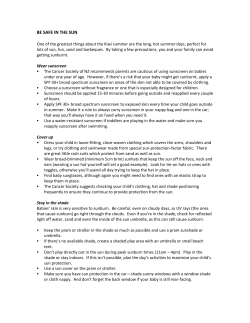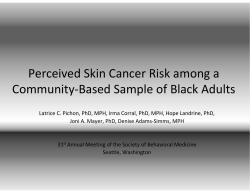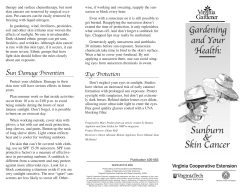
Has the sun protection factor had its day?
Education and debate Has the sun protection factor had its day? Brian Diffey Regional Medical Physics Department, Newcastle General Hospital, Newcastle NE4 6BE Brian Diffey professor b.l.diffey@ncl.ac.uk BMJ 2000;320:176–7 The concept of the sun protection factor was originally proposed by the Austrian scientist Franz Greiter and subsequently adopted by many regulatory authorities and the cosmetic and pharmaceutical industries. It is popularly interpreted as how much longer skin covered with sunscreen takes to burn compared with unprotected skin.1 This interpretation can encourage users to prolong their sun exposure accordingly, yet there is ample evidence that the numerical measure of protection indicated on the product pack is generally higher than achieved in practice.2 This mismatch between expectation and realisation may be one contributing factor to why use of sunscreens has been reported to be a risk factor in melanoma.3 I suggest that the role of sunscreens as a preventive measure against sunburn, and presumably skin cancer, would be strengthened if a qualitative rather than quantitative measure of photoprotection was used. What is the sun protection factor? The sun protection factor is defined as the ratio of the least amount of ultraviolet energy required to produce a minimal erythema on skin protected by sunscreen to the amount of energy required to produce the same erythema on unprotected skin.4 Ten years ago most commercially available sunscreen products had sun protection factors of less than 10, but today there is a trend for higher factors. Most manufacturers make products with factors of 15 to 20, and it is not uncommon to find products claiming a factor of 50 or higher. Not to be outdone, the clothing industry has embraced the notion of sun protection and there is now a British Standard for its measurement.5 How high should the sun protection factor be? The primary function of sunscreens is to prevent sunburn, so just how high should the sun protection factor be to satisfy this requirement? Maximum daily ambient ultraviolet levels, expressed in units of standard erythema dose, under clear summer skies are about 70 in the tropics, 60 at mid-latitudes approximating to those of southern Europe, and 45 for UK latitudes.6 The standard erythema dose is a measure of erythemal ultraviolet radiation7; it requires an exposure of about 1.5 standard erythema doses to produce just perceptible erythema in the unacclimatised skin of sun sensitive people who burn easily and never tan (skin type I),8 about 2 in subjects who burn easily but tan minimally (skin type II), and 3 in subjects who will burn but tan readily (skin type III).9 In the British population about 11%, 30%, and 31% of people are of skin types I, II and III, respectively.1 Clinical studies have shown no difference in the erythemal response to ultraviolet radiation between children ( < 15 years) and adults.10 People are unlikely to receive these maximum ambient exposures simply because it would be unrealistic to 176 Summary points If sunscreens were applied appropriately, to prevent sunburn there would be no need for sun protection factors higher than 15 People who use high factor sunscreens get sunburnt because of inadequate application Numerical indicators of sun protection on sunscreen packaging can cause more confusion than clarity Qualitative measures of labelling sunscreens are proposed that focus more on protection than on encouraging prolonged exposure to sunlight lie in the unshaded sun all day without moving. An extreme sunbather might spend half the time supine and half the time prone, resulting in a maximum exposure on much of the body surface of 50% of ambient. For upright people engaging in various outdoor pursuits—such as gardening, walking, or tennis—the exposure relative to ambient on commonly exposed sites—for example, chest, shoulder, face, forearms, and lower legs—ranges from about 20% to 60%.11 So someone who is on vacation in southern Europe would receive a daily exposure of no more than 20 standard erythema doses over much of the body surface. As an exposure of 2-3 doses is necessary for a minimal erythema in the most common British skin types (II/III), a photoprotective device (sunscreen or clothing) need possess only a sun protection factor of 10 or more to give a holiday without sunburn. For tropical sun exposure, a protection factor of 15 or higher should be more than adequate for all day exposure. Most summer clothing provides protection factors greater than 10; measurements on over 5000 fabrics submitted for testing to the Australian Radiation Laboratory revealed that 97% of fabrics fell into this category.12 More than 85% of fabrics had protection factors of 20 or higher. Why do people who use high factor sunscreens still get sunburnt? If, then, sunscreens of sun protection factor 15 are sufficient to protect against sunburn even for all day exposure in tropical sunshine, why are people who usually or always use high factor (>15) sunscreen more likely to report sunburn than those who rarely or never use sunscreen?13 Conversely, and not surprisingly, fewer people who usually or always sought shade, wore a hat, or wore covering clothes got sunburnt compared with those who rarely or never did so.13 The protection offered by a sunscreen—defined by its sun protection factor—is assessed after it is phototested in vivo at an internationally agreed appliBMJ VOLUME 320 15 JANUARY 2000 www.bmj.com Education and debate CHRIS GARDNER/AP PHOTO a way that impacts adversely on behaviour but where the testing methodology is unlikely to change in the foreseeable future. One way forward is to use qualitative measures of protection, a proposal that has been made previously.19 20 Manufacturers would continue testing products using an application thickness of 2 mg/cm2 to determine the sun protection factor, but products would be labelled as providing low, medium, high, or ultrahigh protection if the measured factor was from 4 to 7, 8 to 14, 15 to 24, or 25 or higher, respectively. Products with protection factors of less than 4 would not be classified as sunscreens. Children and people in strong sunshine for many hours would be encouraged to use high or ultrahigh protection sunscreens, whereas those who wish to tan or are in shady areas might prefer medium or low protection products. Has the time come, therefore, to abandon numerical labelling, which has led to more confusion than clarity, and instead to label sunscreen products with qualitative measures which focus more on protection than on encouraging prolonged exposure to sunlight? Is he being fooled by his sun protection factor? Funding: None. Competing interests: None declared. 1 2 3 cation thickness of 2 mg/cm2. Yet a number of studies have shown that consumers apply much less than this, typically between 0.5 to 1.3 mg/cm2.14–16 Application thickness has a significant effect on protection, with most users probably achieving a mean value of 20-50% of that expected from the product label as a result of common application thicknesses.17 Compounded with this is the likely variability of protection over the skin surface because of application technique.18 So the likely explanation for people getting sunburnt despite using high factor sunscreens is that inadequate amounts of sunscreen were applied or areas of the body were missed, or both, coupled with overexposure to the sun in the belief that they were protected.2 Experience has led consumers to realise that if they want to spend several hours in the sun and avoid sunburn, they need to use products labelled with factors of 20, 30, or higher. The point is that if people applied sunscreens uniformly and appropriately there would be no need for sun protection factors higher than 15. 4 5 6 7 8 9 10 11 12 13 14 Time to abandon the sun protection factor? Why don’t manufacturers test sunscreens at an application thickness that reflects more closely consumer usage—for example, at 1 mg/cm2? Achievement of international harmonisation about a change in methodology is problematic and time consuming. Any single manufacturer would be reluctant to change without this agreement as products currently labelled factor 20, say, would reappear as factor 10, putting the manufacturer at a commercial disadvantage. It seems that we currently have a situation where consumers may be misled about sunscreen protection in BMJ VOLUME 320 15 JANUARY 2000 www.bmj.com 15 16 17 18 19 20 Health Education Authority. Sunscreens and the consumer. London: Health Education Authority, 1996. Diffey BL. People do not apply enough sunscreen for protection. BMJ 1996;313:942. La Vecchia C. Sunscreens and the risk of cutaneous malignant melanoma. Eur J Cancer Prev 1999;8:267-9. Department of Health and Human Services FDA, USA. Sunscreen drug products for over the counter use: proposed safety, effectiveness and labelling conditions. Federal Register 1978; 43:38206-69. British Standards Institution. Method of test for penetration of erythemally weighted solar ultraviolet radiation through clothing fabrics. London: British Standards Institution. (BS 7914:1998.) Roy C, Gies H, Toomey S. Monitoring UV-B at the earth’s surface. Cancer Forum 1996;20:173-9. CIE Standard. Erythema reference action spectrum and standard erythema dose. Vienna: Commission Internationale de l’Éclairage, 1998. (CIE S 007/E-1998.) Lock-Andersen J, Wulf HC, Mortensen NN. Erythemally weighted radiometric dose and standard erythema dose. In: Hönigsmann H, Knobler RM, Trautinger F, Jori G, eds. Landmarks in photobiology. Milan: Organizzazione Editoriale Medico Farmaceutica, 1998:315-7. Weinstock MA. Assessment of sun sensitivity by questionnaire: validity of items and formulation of a prediction rule. J Clin Epidemiol 1992;45:547-52. Cox NH, Diffey BL, Farr PM. The relationship between chronological age and the erythemal response to ultraviolet B radiation. Br J Dermatol 1992;126:315-9. Diffey BL. Human exposure to ultraviolet radiation. In: Hawk JLM, ed. Photodermatology. London: Arnold, 1999:5-24. Gies HP, Roy CR, McLennan A. Textiles and sun protection. In: Volkmer B, Heller H, eds. Environmental UV-radiation, risk of skin cancer and primary prevention. Stuttgart: Gustav Fischer, 1996:213-34. Dixon H, Shatten R, Borland R. Reaction to the 1995/1996 SunSmart Campaign: results from a representative household survey of Victorians. Melbourne: Anti-Cancer Council of Victoria, 1997:70-96. (SunSmart evaluation studies No 5.) Gottlieb A, Bourget TD, Lowe NJ. Sunscreens: effects of amounts of application of sun protection factors. In: Lowe NJ, Shaath NA, Pathak MA, eds. Sunscreens: development, evaluation, and regulatory aspects. New York: Marcel Dekker, 1997:583-8. Stenberg C, Larkö O. Sunscreen application and its importance for the sun protection factor. Arch Dermatol 1985;121:1400-2. Bech-Thomsen N, Wulf HC. Sunbathers’ application of sunscreen is probably inadequate to obtain the sun protection factor assigned to the preparation. Photodermatol Photoimmunol Photomed 1993;9:242-4. Stokes RP, Diffey BL. How well are sunscreen users protected? Photodermatol Photoimmunol Photomed 1997;13:186-8. Rhodes LE, Diffey BL. Quantitative assessment of sunscreen application technique by in vivo fluorescence spectroscopy. J Soc Cosmet Chem 1996;47:109-15. Garmyn MA, Murphy GM, Gibbs NK, Hawk JLM. Are the protection factors assigned to proprietary sunscreen products misleading? Photodermatol 1986;3:104-6. Marks S. Summer in Australia: skin cancer and the great SPF debate. Arch Dermatol 1995;131:462-4. (Accepted 15 October 1999) 177
© Copyright 2025










